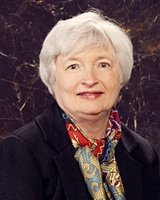Fed to reduce bond purchases, keep rates unchanged
19 Jun 2014
The US Federal Reserve on Wednesday announced plans to reduce the pace of its bond buying programme in the light of improvement in the overall economy, but decided to maintain an accommodative monetary policy in order to support continued progress toward maximum employment and price stability.
 Beginning in July, the Fed will add to its holdings of agency mortgage-backed securities at a pace of $15 billion per month rather than $20 billion per month, and will add to its holdings of longer-term treasury securities at a pace of $20 billion per month rather than $25 billion per month.
Beginning in July, the Fed will add to its holdings of agency mortgage-backed securities at a pace of $15 billion per month rather than $20 billion per month, and will add to its holdings of longer-term treasury securities at a pace of $20 billion per month rather than $25 billion per month.
The Federal Open Markets Committee (FOMC) meeting on Wednesday also decided to keep interest rate on the federal funds at the current 0 to 0.25 per cent target range with the objective of achieving maximum employment and keeping inflation rate below 2 per cent.
The FOMC said it expected to keep the federal fund rate at the current lows for a considerable time after the Fed's bond purchase programme ends, especially if projected inflation continues to run below the Committee's 2 per cent longer-run goal, and provided that longer-term inflation expectations remain well anchored.
"If incoming information broadly supports the committee's expectation of ongoing improvement in labor markets, and inflation moving back over time to its longer-run objective, the committee will likely continue to reduce the pace of asset purchases in measured steps in future meetings," Federal Reserve chairperson Janet Yellen said
The Fed said it would continue to monitor a wide range of information, including measures of labor market conditions, indicators of inflation pressures and inflation expectations, and readings on financial developments.
Growth in economic activity in the United States has rebounded in recent months with some improvement in labor market, household spending and fixed investment in business, the FOMC said in remarks on Thursday.
Fiscal policy is restraining economic growth, although the extent of restraint is diminishing. Inflation has been running below the committee's longer-run objective, but longer-term inflation expectations have remained stable, it noted.
The committee said, with appropriate policy accommodation, it expects economic activity in the US to expand at a moderate pace and labor market conditions to continue to improve gradually.
The committee, however, noted that inflation persistently below its 2 per cent objective could pose risks to economic performance, and that it continues to monitor inflation developments carefully for evidence that inflation will move back toward its objective over the medium term.
The broader economy has sufficient underlying strength to support ongoing improvement in labor market conditions. In light of the cumulative progress toward maximum employment and the improvement in the outlook for labor market conditions since the inception of the current asset purchase programme, the committee said it has decided to make a further measured reduction in the pace of its asset purchases.
The Fed will continue to reinvest principal payments from its holdings of agency debt and agency mortgage-backed securities in agency mortgage-backed securities and will roll over maturing treasury securities at auction.
The committee's sizable and still-increasing holdings of longer-term securities should maintain downward pressure on longer-term interest rates, support mortgage markets, and help to make broader financial conditions more accommodative, which in turn should promote a stronger economic recovery and help to ensure that inflation, over time, it pointed out.
Fed policymakers sharply lowered their forecast for economic growth but took note of improved conditions that should help lower the unemployment rate further yet keep short-term interest rates at or near zero until next year.
The FOMC projected economic growth for this year at 2.3 per cent, down from 3 per cent forecast in March. The downgrade reflects shrinking economic output in the first quarter, which the Fed and most experts saw as a temporary outcome of the harsh winter weather.
The Fed, in its quarterly projections, also raised by a notch its outlook for inflation this year, but still sees it falling short of its 2 per cent target.






























